Comforter
Can I Machine Wash My Ugg Comforter
Pondering if you can machine wash your UGG comforter? Prepare to discover the expert tips that will keep it cozy and clean.
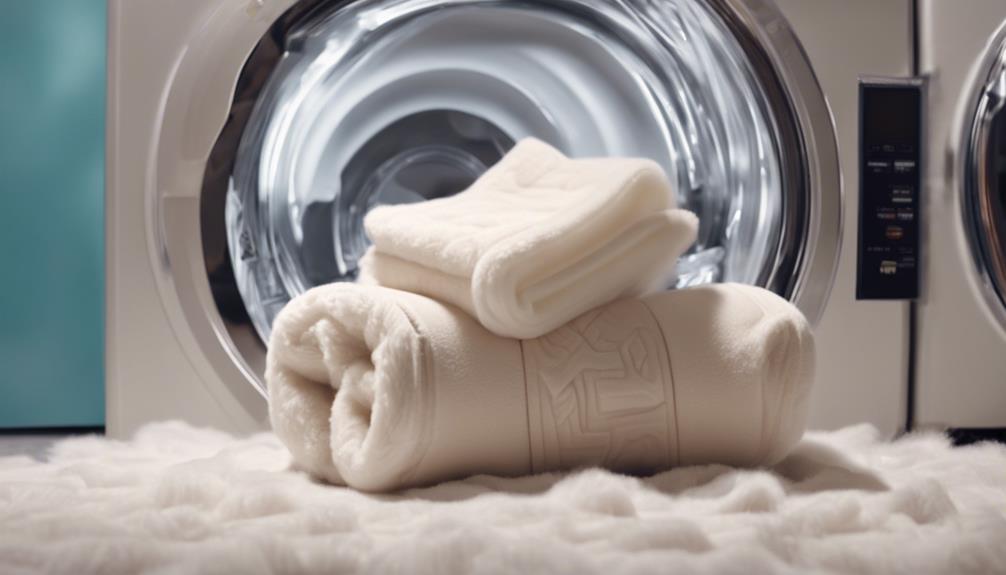
Yes, you are able to machine wash your UGG comforter. Refer to the care label for machine wash instructions, select a gentle cycle with cold water, and wash separately or with similar items. Avoid using harsh chemicals or bleach to preserve its durability and plushness. For a more detailed guide on machine washing your UGG comforter and tips to ensure its longevity and softness, please follow our expert recommendations. Use mild, hypoallergenic detergent and air dry for optimal results. Maintain your UGG comforter’s freshness by adhering to proper washing techniques and stain removal strategies. Be assured that with proper care, your UGG comforter will continue to provide warmth and comfort.
Key Takeaways
- Check care label for machine washability and specific instructions
- Use a front-loading machine with a gentle cycle for washing
- Wash separately or with similar items to prevent damage
- Opt for a mild detergent suitable for delicate fabrics
- Air dry the comforter to maintain quality and fluffiness
Care Instructions for Machine Washing UGG Comforter
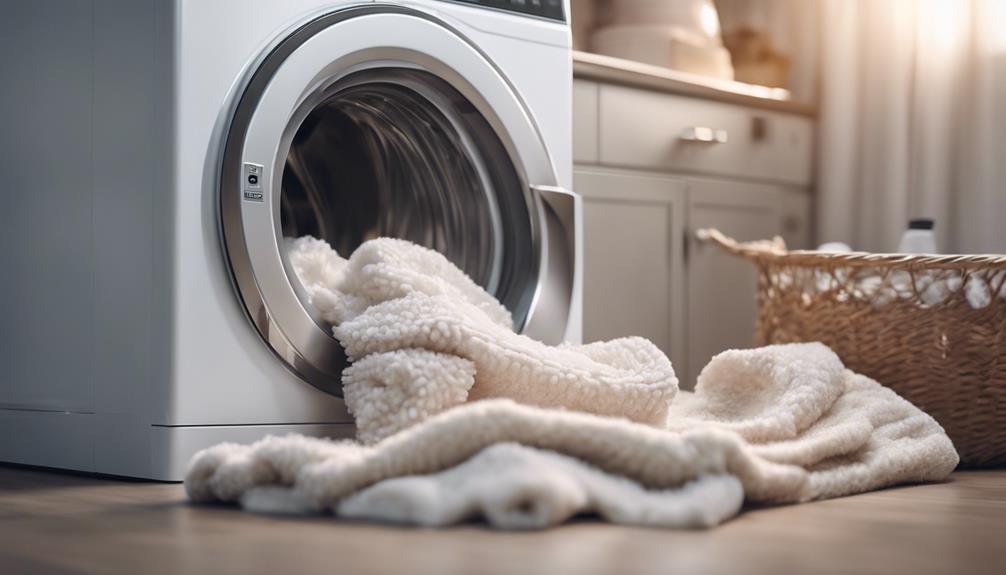
To properly care for your Ugg comforter by machine washing, follow the specific care instructions provided to guarantee the best results. Before tossing your Ugg comforter into the washing machine, make sure to check the care label to confirm it's safe for machine washing.
When it comes to machine washing your Ugg comforter, opt for a gentle cycle and cold water. This will help prevent any damage to the delicate fibers of the comforter. It's also advisable to wash the comforter separately or with similar items to ensure even wear and thorough cleaning.
Additionally, avoid using harsh chemicals or bleach when machine washing your Ugg comforter. These substances can compromise the quality and softness of the fabric. By following these care instructions for machine washing your Ugg comforter, you can maintain its durability and plushness for a longer period.
Choosing the Right Detergent for UGG Comforter
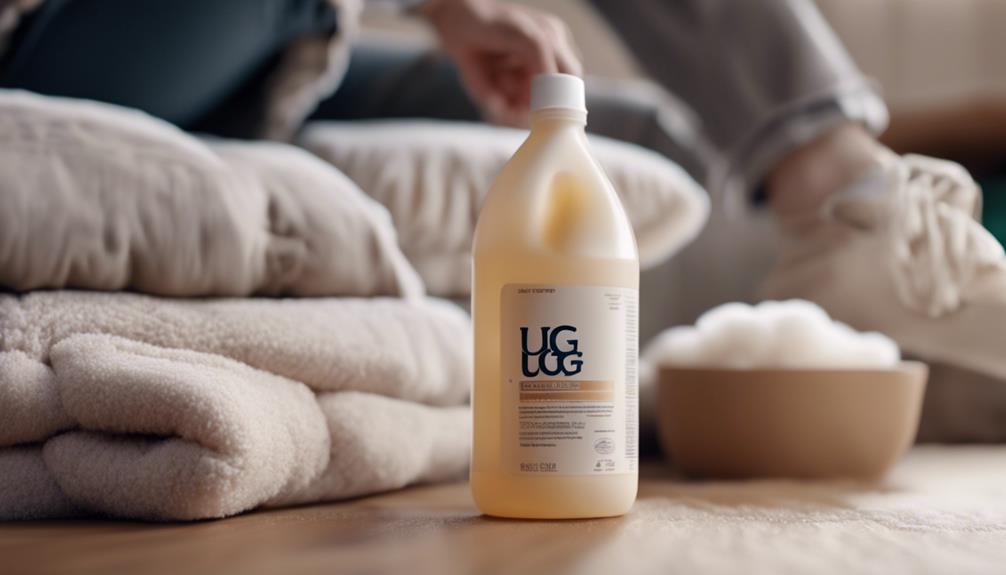
When selecting a detergent for your UGG comforter, it's important to choose a mild option that's gentle on delicate fabrics.
Opt for hypoallergenic and dermatologist-tested detergents to guarantee compatibility with your UGG comforter and prevent skin irritation.
Consider eco-friendly options with plant-based ingredients for a more sustainable washing process.
Proper Detergent Selection
When washing your UGG comforter, opt for a mild detergent to protect the delicate fibers and maintain quality. Selecting a hypoallergenic and dermatologist-tested detergent guarantees gentleness on the comforter, while choosing a plant-based option offers an eco-friendly alternative.
If you enjoy a subtle scent, go for a lightly fragranced detergent to add a pleasant aroma to your freshly washed UGG comforter. It's important to avoid harsh chemicals in detergents to preserve the fluffiness and overall quality of your UGG comforter.
Compatibility With UGG
For the optimal outcome in washing your UGG comforter, choose a mild detergent that's gentle on the delicate fibers. Opting for a hypoallergenic detergent, which is dermatologist-tested, will help maintain the quality of your comforter.
Consider using a plant-based detergent to reduce environmental impact while keeping your UGG comforter clean. If you enjoy a light fragrance on your bedding, select a lightly scented detergent.
Harsh chemicals should be avoided as they can compromise the fluffiness and softness of your UGG comforter. By selecting the right detergent, you can be confident that your UGG comforter remains cozy and in top condition after each wash.
Machine Washing Steps for UGG Comforter
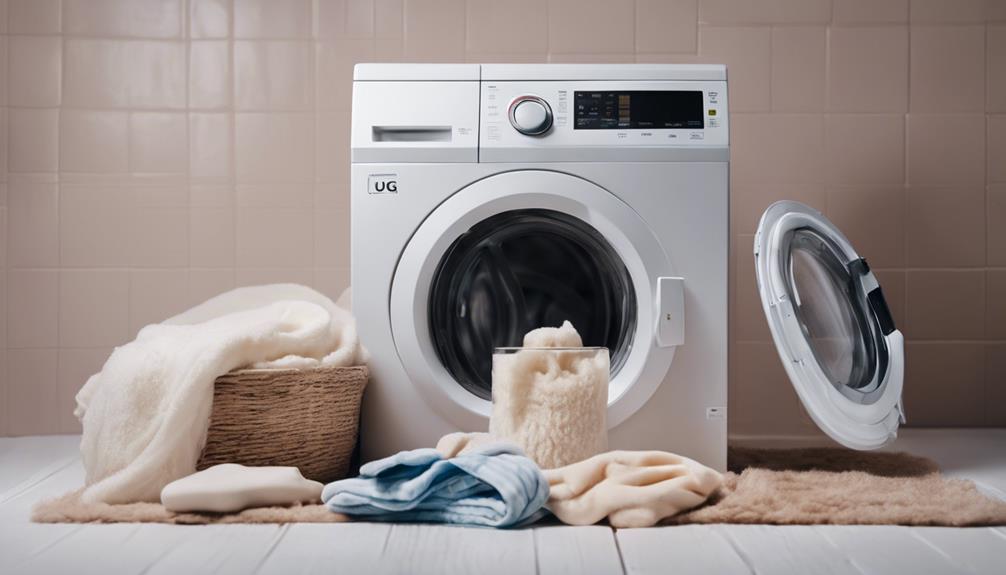
To properly machine wash your UGG comforter, make sure that you check the care label for machine washability and select a front-loading washing machine with a gentle cycle. Before starting the washing process, make certain that your comforter isn't too large for the machine to allow proper cleaning. If it is, consider using a laundromat with a larger capacity machine. When loading the comforter into the machine, wash it separately or with items of similar fabric and color to avoid any potential damage during the wash cycle.
Next, add a mild detergent specifically designed for delicate fabrics. Avoid using hot water, as it can cause shrinkage or damage to the filling of the comforter. Opt for a gentle cycle to ensure a thorough yet safe cleaning process. Once the wash cycle is complete, remove the UGG comforter promptly and hang it to air dry. This method helps maintain the quality and fluffiness of your comforter. Remember to avoid harsh detergents that could potentially harm the fabric.
Avoiding Common Mistakes in UGG Comforter Washing

When washing your UGG comforter, it's important to adhere to the care label instructions and avoid using hot water or harsh detergents to prevent damage. Proper washing techniques, selecting the right detergent, and opting for suitable drying methods are essential to maintain the quality of your comforter.
Overloading the washing machine or choosing the wrong settings can lead to fiber damage or shrinking, so it's important to follow these guidelines for successful UGG comforter washing.
Proper Washing Techniques
What're the key steps to guarantee successful machine washing of your UGG comforter while avoiding common mistakes?
When machine washing your UGG comforter, it's important to use a front-loading washing machine on a gentle cycle to prevent damage.
Always follow the care label instructions provided by the manufacturer to maintain the quality of the comforter.
To make sure of even wear, wash the comforter and shams together in a separate load.
Prior to washing, pre-treat any stains promptly to enhance the likelihood of effective stain removal.
For added protection, consider using a mesh laundry bag for the shams to prevent tangling or damage during the wash cycle.
Choosing the Right Detergent
We always choose a mild detergent when washing our UGG comforter to guarantee the fabric remains undamaged and retains its softness and fluffiness. Selecting an essential detergent is important to avoid harsh chemicals that can strip the comforter's delicate fibers.
Opt for hypoallergenic and dermatologist-tested detergents to prevent any potential skin irritation, especially if you have sensitive skin. Consider using plant-based detergents for a more eco-friendly and gentle wash that maintains the quality of your UGG comforter.
If you enjoy a subtle scent, choose a lightly fragranced detergent to add a pleasant aroma to your freshly washed comforter without overwhelming the fabric. Make sure to follow the detergent manufacturer's instructions for the best results.
Drying Methods for UGG
To maintain the quality and fluffiness of your UGG comforter, opt for air drying instead of using a machine dryer. When air drying, consider hanging your comforter in a well-ventilated area.
Sunlight can be beneficial as it helps sanitize and freshen the comforter during the drying process. However, be cautious of prolonged exposure to direct sunlight to prevent sun bleaching and potential color fading.
It's crucial to monitor the drying time to make certain the comforter isn't left out for too long. Additionally, make sure the surface where you hang your comforter is clean to avoid dirt or debris transferring back onto it.
Following these steps can help sustain the quality of your UGG comforter for longer.
Drying Tips for UGG Comforter
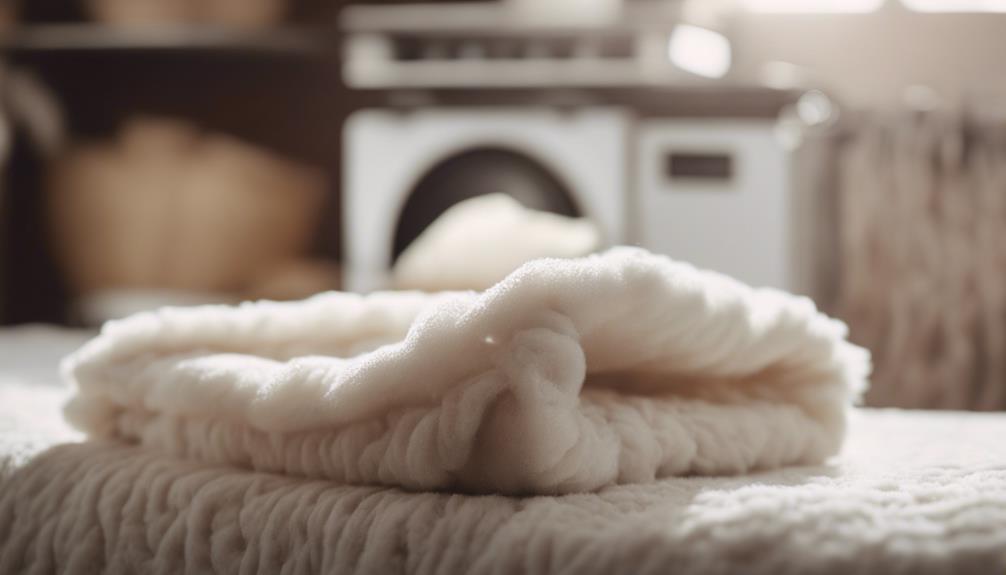
Hanging the UGG comforter to air dry preserves its quality and enhances sanitation. It's important to avoid machine drying to prevent any potential damage to the fibers. By allowing the comforter to air dry naturally, you not only maintain its quality but also help freshen it up. Here are some tips to guarantee effective drying:
| Drying Tips for UGG Comforter |
|---|
| Hang your comforter in a well-ventilated area |
| Avoid direct sunlight to prevent sun bleaching |
| Make sure the comforter is completely dry before use |
| Use a clean and suitable surface for drying |
Following these tips will help uphold the quality of your UGG comforter and ensure it stays fresh and cozy. Remember to monitor the drying time carefully to prevent any potential issues.
Maintaining Fluffiness of UGG Comforter
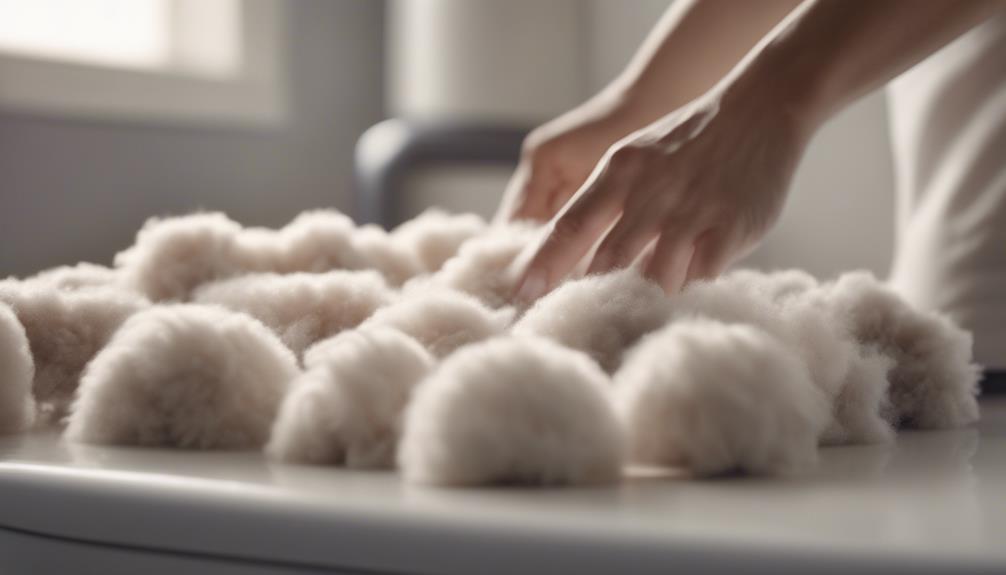
Maintaining the fluffiness of your UGG comforter requires regular shaking and fluffing to preserve its soft texture between washings. While machine washing can be convenient, it may lead to a loss of fluffiness over time due to the agitation of the machine.
The agitators in washing machines can cause the comforter's fibers to clump together, resulting in a less fluffy appearance. To minimize this impact, consider using a gentle cycle and mild detergent when washing your UGG comforter. After washing, air drying the comforter can help preserve its fluffiness by allowing the fibers to naturally regain their loft.
Additionally, regularly shaking out the comforter and fluffing it up can also aid in maintaining its fluffy texture between washings. By following these tips and being mindful of the washing process, you can help guarantee that your UGG comforter stays soft, fluffy, and cozy for a long time.
Stain Removal Techniques for UGG Comforter

Regularly addressing stains on your UGG comforter is vital to maintain its pristine appearance and longevity. When dealing with stains, it's important to act promptly using gentle detergent and a damp cloth or sponge to dab at the affected area. Avoid aggressive rubbing or scrubbing, as this can damage the fabric.
Before using any stain removal solution, test it on a small, inconspicuous area to make sure it doesn't impact the color of the comforter. For tough stains, consider using an enzyme-based cleaner specifically designed for fabrics.
After treating the stain, remember to blot the area with a clean, dry cloth to soak up excess moisture and prevent it from spreading. By following these cleaning tips and using the appropriate stain removal techniques, you can effectively maintain the quality and appearance of your UGG comforter for years to come.
Long-Term Care for UGG Comforter
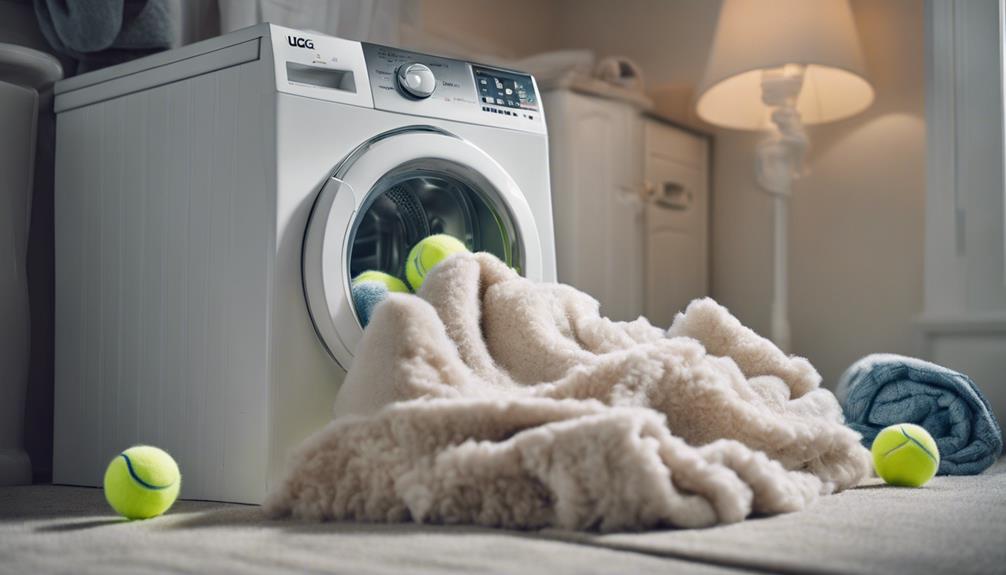
When it comes to guaranteeing the longevity of your UGG comforter, proper long-term care is key, including following specific washing guidelines for machine washing. Using a front-loading washing machine on a gentle cycle is the best way to clean your UGG comforter without causing damage.
Always remember to check the care label on the comforter for any specific washing instructions provided by the manufacturer. It's recommended to wash the comforter every 3-6 months to maintain its cleanliness and extend its lifespan. However, if you're sensitive to allergens or live in dusty environments, you may need to launder the comforter more frequently.
Frequently Asked Questions
Can I Put My UGG Blanket in the Washer?
Yes, we can put our UGG blanket in the washer. It's safe to machine wash it in a front-loading machine on a gentle cycle. Use a mild detergent and avoid harsh chemicals to protect the blanket.
Washing it with similar items can help maintain its quality and prevent uneven wear. Always check the care label for specific instructions. Avoid washing large UGG blankets in machines with agitators to prevent fiber damage.
What Happens to Uggs in the Washing Machine?
When we wash Uggs in the machine, the delicate fibers can get damaged, affecting their fluffiness.
Agitation might cause the fabric to wear down, losing softness over time.
Spinning too much can lead to uneven filling distribution, making the Uggs lumpy.
It's best to follow manufacturer's care instructions to avoid potential issues and maintain the product's quality.
How Do You Get Stains Out of White UGG Comforters?
To effectively remove stains from white UGG comforters, gently treat them immediately with cold water and a mild detergent. Avoid harsh scrubbing to prevent damage. Test a small hidden spot first to confirm the cleaning solution won't affect the color.
Air dry the comforter after spot cleaning to preserve its quality and brightness. Following these steps will help maintain the pristine look of your white UGG comforter.
Can I Put My Uggs in the Dryer?
No, it isn't recommended to put Uggs in the dryer. The heat can damage the sheepskin material, causing shrinkage and stiffness.
For best results, air drying is the way to go. Avoid direct heat sources like radiators and sunlight to prevent harm.
Let your Uggs air dry at room temperature to maintain softness and shape. This method preserves quality and longevity, ensuring comfort when wearing them.
Is Dry Cleaning or Machine Washing More Suitable for Cleaning My Ugg Comforter?
When it comes to cleaning your Ugg comforter, it is best to opt for dry cleaning. Machine washing can damage the delicate fabric and construction of the comforter, leading to shrinkage and loss of softness. To maintain the quality and longevity of your Ugg comforter, it’s recommended to dry clean Ugg comforter.
Conclusion
To sum up, machine washing your UGG comforter is a straightforward process that can help maintain its quality and comfort.
Just like a gentle spin cycle, proper care and attention will guarantee your comforter stays fluffy and cozy for years to come.
Remember to follow the care instructions, use the right detergent, and avoid common washing mistakes to keep your UGG comforter looking and feeling its best.
Happy washing!
Comforter
Where Can I Donate Comforter
Need a place to donate your comforter? Look no further for tips on where to donate and make a difference.
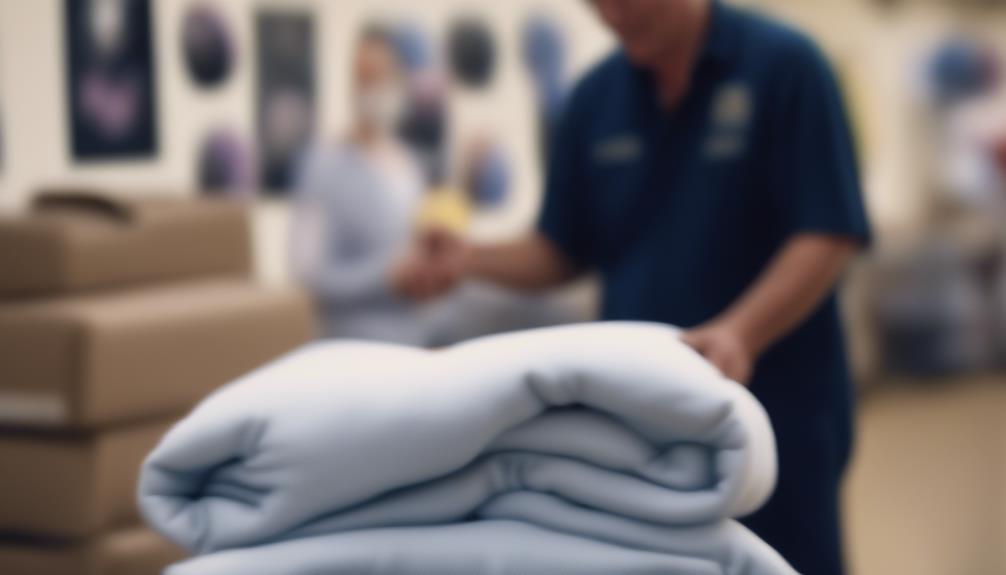
When giving away comforters, think about the American Red Cross, Salvation Army, and Goodwill for gently used items. Make sure they are in good condition. Churches, homeless shelters, and animal shelters also appreciate comforter donations to assist those in need. Local community centers are another good choice. Please refrain from donating heavily damaged comforters or mattresses. Look for drop-off locations or pick-up services for your convenience. Your donation could greatly help provide warmth and comfort. Other alternatives include environmental recycling programs for used textiles. Explore different ways to help those in need. More opportunities are available to expand your generosity.
Key Takeaways
- American Red Cross, GreenDrop, Salvation Army, and Goodwill accept gently used comforters.
- Check with local churches, homeless shelters, and animal shelters for donation opportunities.
- Utilize waste management services or recycling programs for eco-friendly disposal.
- Support community centers by donating comforters to help those in need in the local area.
- Consider organizing donation drives with businesses or organizations to amplify the impact of your donation.
Nationwide Donation Centers
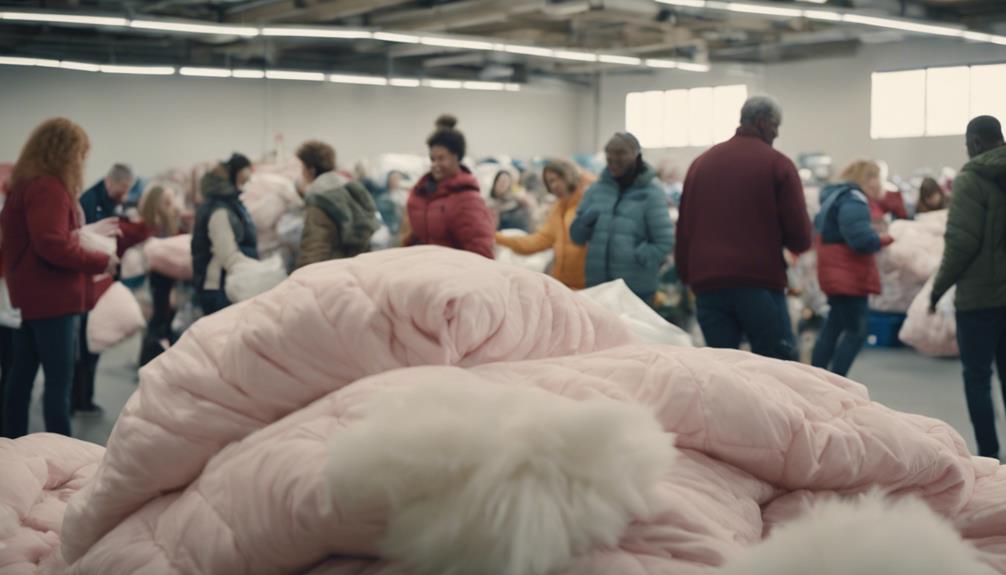
Nationwide, we can easily donate comforters to various organizations that accept bedding and textiles for donation, such as the American Red Cross GreenDrop program, Salvation Army, and Goodwill. When considering where to donate bedding or clothes, it's crucial to make sure that the items are gently used and in good condition. These donation centers welcome household goods, including old sheets and towels, to assist those in need.
It's worth mentioning that charities nationwide typically can't accept mattresses or severely damaged comforters. By donating these items, not only are we decluttering our homes, but we're also contributing to a good cause. Additionally, many donation centers offer the convenience of drop-off locations or pick-up services, making the donation process even more accessible. Remember to keep track of your donations, as you may be eligible for a tax deduction, providing an extra incentive to donate to those in need.
Churches and Faith-Based Organizations

When considering where to donate gently used comforters, churches and faith-based organizations play an important role in providing warmth and comfort to those in need within their communities. Comforter donations to churches can make a significant difference in the lives of individuals facing homelessness or difficult circumstances. Many churches distribute these donated comforters to families, individuals, and shelters to make sure that those without adequate bedding receive the support they need.
Homeless Shelters

Donating a comforter to a homeless shelter can directly impact someone in need by providing warmth and comfort during cold weather. Homeless shelters often rely on donations of comforters to help meet the basic needs of their residents. By donating a clean and gently used comforter, you can help support individuals experiencing homelessness by offering them a warm bed in a sheltered environment. These donations play an important role in creating a safe and comfortable space for those seeking refuge.
Comforters are appreciated by homeless shelters for their ability to provide warmth and a sense of security to residents facing harsh living conditions. When considering donating to a homeless shelter, reach out to local shelters in your community to inquire about their specific needs and donation guidelines. Your contribution can make a meaningful difference in the lives of those who are without a permanent home. By supporting homeless shelters with comforter donations, you're helping to make sure that individuals in need have access to essential warmth and comfort.
Animal Shelters
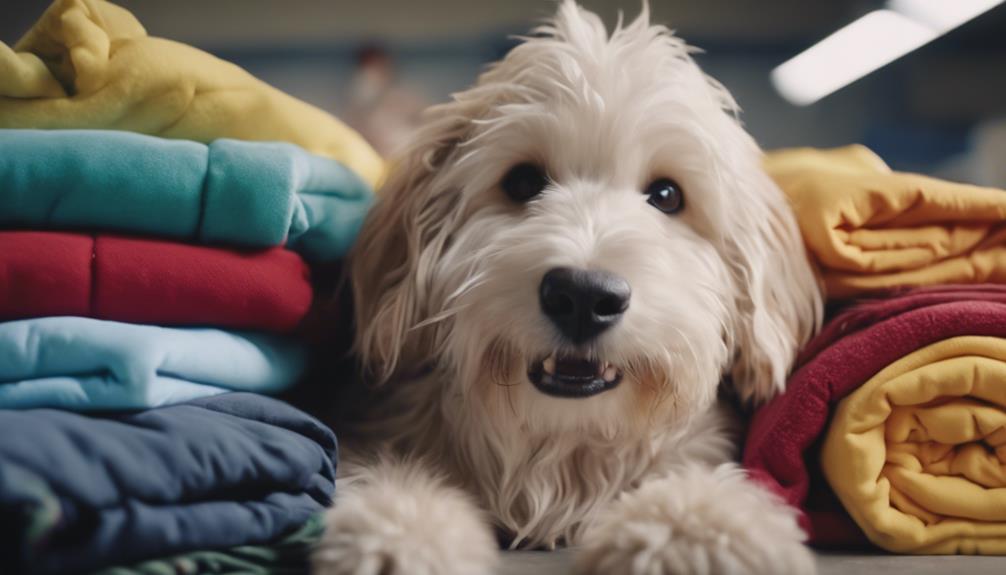
When considering donating comforters to animal shelters, it's crucial to understand the shelter's specific needs and the process for making donations.
Providing clean and gently used comforters can greatly benefit shelter animals by offering them warmth and comfort while they await adoption.
Shelter Needs
At animal shelters, comforters play a vital role in providing warmth and comfort to shelter animals. These cozy bedding essentials help create a comfortable environment for homeless pets awaiting their forever homes. When you donate clean and gently used comforters to animal shelters, you're contributing to the well-being and contentment of shelter animals.
Your contribution of comforters can make a significant difference in the lives of these animals, offering them a soft place to rest and feel secure. By providing comforters for shelter animals, you help guarantee that they've a warm and inviting space while they wait for adoption.
Your support in donating comforters to animal shelters is greatly appreciated and valued.
Donation Process
As we consider the process of contributing comforters to animal shelters, it's important to understand how these donations directly impact the well-being of shelter animals. When you donate comforters to animal shelters, you're helping to create a cozy environment for the animals awaiting their forever homes.
Here are some key points to keep in mind during the donation process:
- Your donation of clean and gently used comforters can provide warmth and comfort to shelter animals.
- Comforters play an essential role in keeping animals cozy and at ease during their stay at the shelter.
- Donated comforters can be repurposed as bedding or for various animal care needs within the shelters.
- Contributing comforters to animal shelters assists in enhancing the overall comfort and well-being of the rescued animals.
Salvation Army and Goodwill
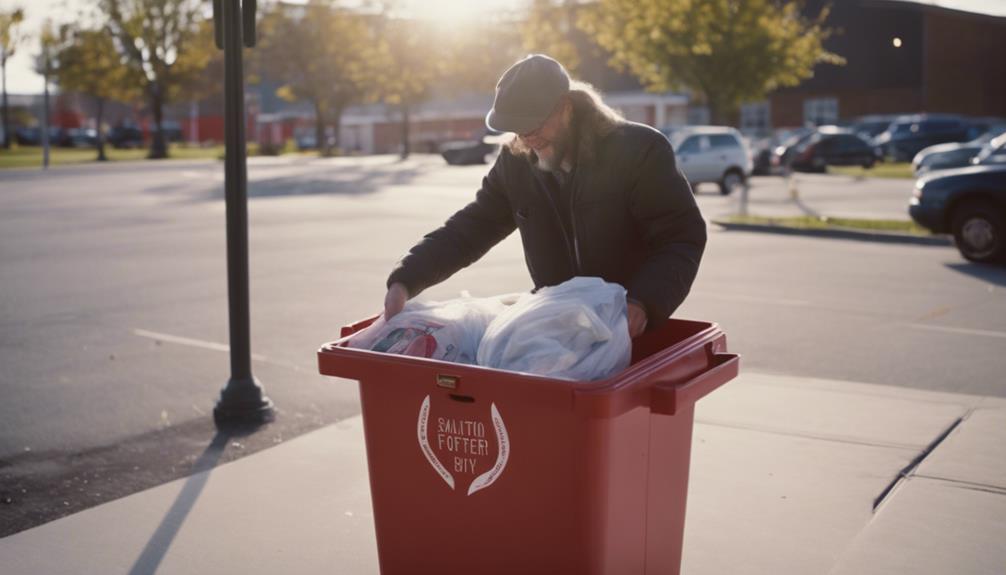
At Salvation Army and Goodwill, you can locate convenient drop-off locations for donating comforters. Make sure your comforter is in good condition before giving it to support their community initiatives and employment training programs.
The donation process is straightforward and impactful, contributing to both environmental sustainability and social welfare.
Donation Locations
Donating gently used comforters to the Salvation Army and Goodwill is a simple way to support those in need and contribute to their charitable programs. When looking to donate, consider the following about these donation locations:
- Both Salvation Army and Goodwill are reputable donation centers.
- They offer convenient drop-off locations for your comforter donations.
- Pick-up services are available for larger items, making it easier for you to donate.
- Your donations help fund various charitable programs and services in the community.
Acceptable Comforter Conditions
When donating comforters to Salvation Army and Goodwill, make sure they're clean and in good condition without rips, stains, or odors. Both organizations accept gently used comforters that are free of any damage or unpleasant smells.
Ensuring your comforters meet these essential conditions is vital for your donation to be utilized effectively for those in need. Ripped or stained comforters may not be accepted, as these flaws can limit the reusability of the items.
Donation Process
To donate comforters to Salvation Army and Goodwill, simply visit their drop-off locations or schedule a pick-up service for convenience. Make sure the comforters are clean and in good condition to support their reuse.
Here are some steps to facilitate your donations:
- Check the Salvation Army website for drop-off locations near you.
- Contact Goodwill to inquire about their donation process and pick-up services.
- Wash and fold the comforters neatly before donating to guarantee they're ready for reuse.
- Consider donating other items along with the comforters to maximize your impact on community services and employment training programs.
Environmental Recycling Programs
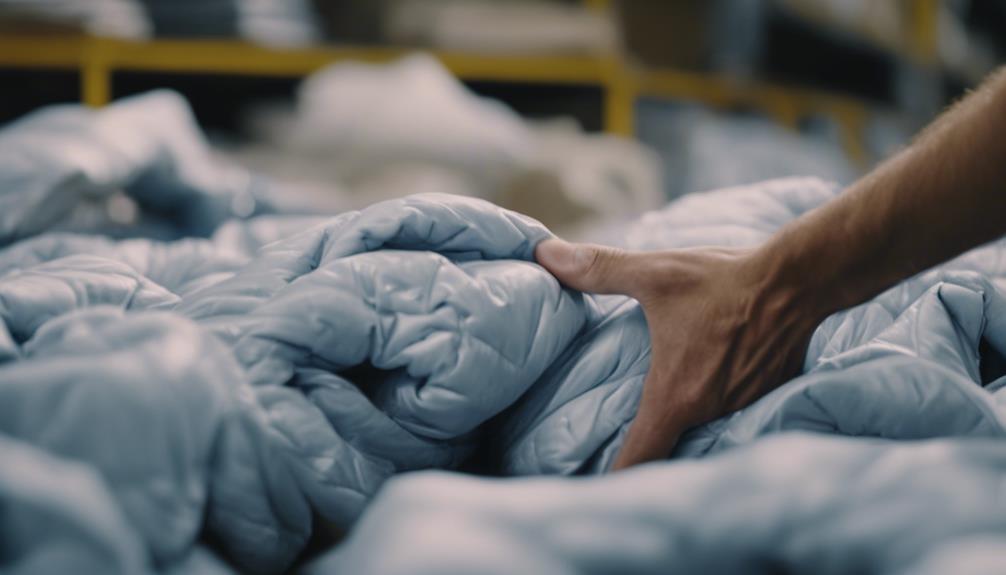
In our efforts to promote sustainability, exploring environmental recycling programs offers a practical solution for donating old comforters. Organizations like TerraCycle and American Textile Recycling Service specialize in textile recycling, including repurposing comforters to reduce waste and support environmental sustainability. TerraCycle utilizes Zero Waste Boxes to streamline the recycling process for comforters and other textiles. On the other hand, American Textile Recycling Service has convenient drop-off bins scattered across the United States, making it easy for individuals to recycle their old comforters responsibly. By participating in these recycling programs, you can contribute to the circular economy by giving your comforters a new life instead of letting them end up in landfills. Check out the table below for a quick overview of these environmental recycling programs:
| Recycling Program | Key Features |
|---|---|
| TerraCycle | Utilizes Zero Waste Boxes for easy recycling |
| American Textile Recycling Service | Provides drop-off bins across the U.S. |
Local Community Centers

Community centers in your area gladly accept comforter donations to assist individuals and families in need. Donating comforters to these local community centers can make a significant impact on someone seeking warmth and comfort during challenging times.
Here are some reasons why donating comforters to community centers is beneficial:
- Warmth and Comfort: Your donation can provide much-needed warmth and comfort to those facing hardship.
- Serve Clients: Community centers rely on donations like comforters to effectively serve their clients in need.
- Direct Impact: By donating a comforter, you can directly impact someone in your local community and make a positive difference in their life.
- Supporting Individuals in Need: Your contribution helps support individuals in need within your community, ensuring they have essential items for a better quality of life.
Consider reaching out to your local community center to inquire about their specific donation guidelines and how you can contribute to helping those in need.
Frequently Asked Questions
How Do I Donate Used Bedding?
To donate used bedding, clean and repair it first. Check requirements with donation organizations. Local shelters, Goodwill, and Salvation Army accept comforter donations.
Consider recycling at textile centers like American Textile Recycling Service. Repurpose old comforters into quilts or DIY projects.
Always make sure items are in good condition for donation.
Should I Wash a Comforter Before Donating?
Yes, washing a comforter before donating is crucial. It guarantees cleanliness and removes dirt, allergens, and odors.
Clean comforters are more likely to be accepted by donation centers and show consideration for the recipient's well-being. By washing the comforter, you contribute to a positive donation experience and help maintain the quality of donated items.
It's a simple step that can make a big difference in someone else's comfort and hygiene.
Do Salvation Army Take Bedding?
Yes, the Salvation Army does accept bedding donations, including comforters. Donated comforters should be clean, in good condition, and free of stains or tears.
Giving bedding to the Salvation Army supports their programs for those in need. It's a great way to give back to the community.
For specific guidelines on bedding donations, reach out to your local Salvation Army location.
What Items Does Purple Heart Not Accept?
Purple Heart doesn't accept items like mattresses, box springs, pianos, organs, waterbeds, large appliances, carpeting, built-in fixtures, ammunition, or hazardous materials.
Additionally, they don't take used tires, automotive parts, construction materials, or large exercise equipment.
Furthermore, the organization doesn't welcome food, open containers, perishable items, or broken, soiled, or repair-needed items.
Cribs, car seats, walkers, and baby items are also not suitable for Purple Heart donations.
Is it possible to donate a down comforter, and if so, where can I do so?
Yes, it is possible to donate down comforters. Many shelters, thrift stores, and charity organizations accept gently used down comforters. You can also check with local animal shelters, as they often accept down comforters for bedding. For more information, check out this donate down comforters article.
Conclusion
So, if you're looking to donate your comforter, there are plenty of options available.
Did you know that in the United States alone, over 550,000 people experience homelessness on any given night?
By donating your comforter to a local shelter, you can help provide warmth and comfort to those in need.
Consider reaching out to one of the organizations mentioned in this article to make a difference in someone's life today.
Comforter
How Long Does It Take a Down Comforter to Fluff up
Wondering how long it takes for a down comforter to fluff up? Discover the key to achieving ultimate loftiness and comfort.
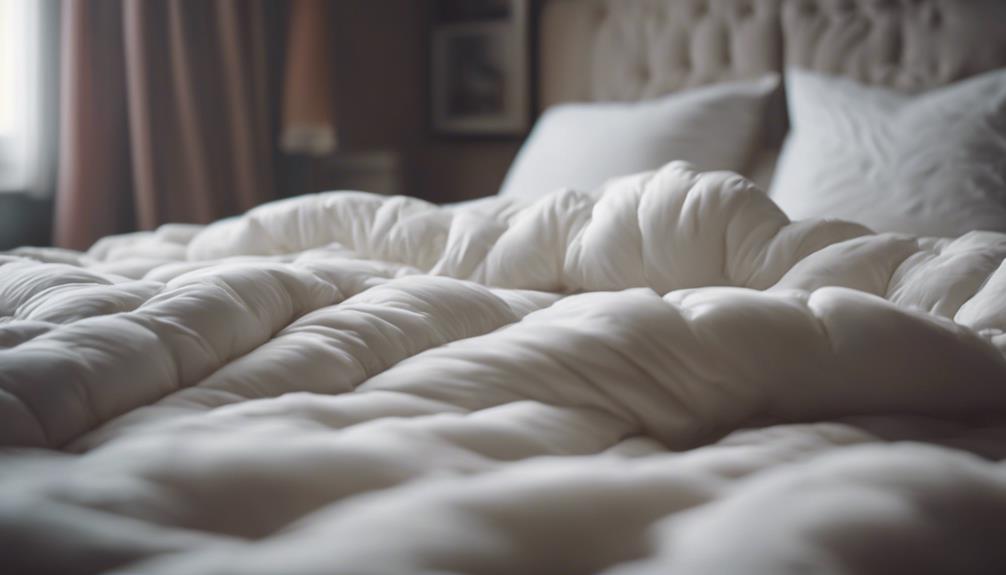
When waiting for a down comforter to fluff up, it usually takes a few hours if left on the bed. To speed up the process, try daily shaking and airing. These activities can help restore the loftiness of the comforter. Patience is key, as some comforters may continue to gain loft for up to two weeks. If your comforter still doesn’t feel fluffy, replacement might be necessary. Proper care and maintenance are also important for quick fluffing. Keep up the routine for best results and loftiness. Additional insights await for enhancing your down comforter’s fluffiness.
Key Takeaways
- Daily shaking and airing aid in loftiness restoration.
- New comforters may take hours to fully fluff up.
- Continued loft gain possible for up to two weeks.
- Replacement consideration if persistent flatness persists.
- Proper care accelerates the down comforter fluffing process.
Factors Affecting Fluffing Time
Factors affecting the time it takes for a down comforter to fluff up can include the quality of the down fill, the thickness of the comforter shell, and the frequency of shaking and airing.
When dealing with a new down comforter, it's important to allow time for the down to settle and expand properly. One way to speed up this process is by using a wool dryer on a no-heat or air fluff setting. Placing the comforter in the dryer with a few wool dryer balls can help fluff up the down clusters. However, it's vital to check the manufacturer's instructions first to make sure this method is safe for your specific comforter.
Additionally, regularly shaking and airing out the comforter can also aid in enhancing its loftiness. By incorporating these practices, you can help your new down comforter reach its full fluff potential in a shorter amount of time.
Sunlight Vs. Dryer Method
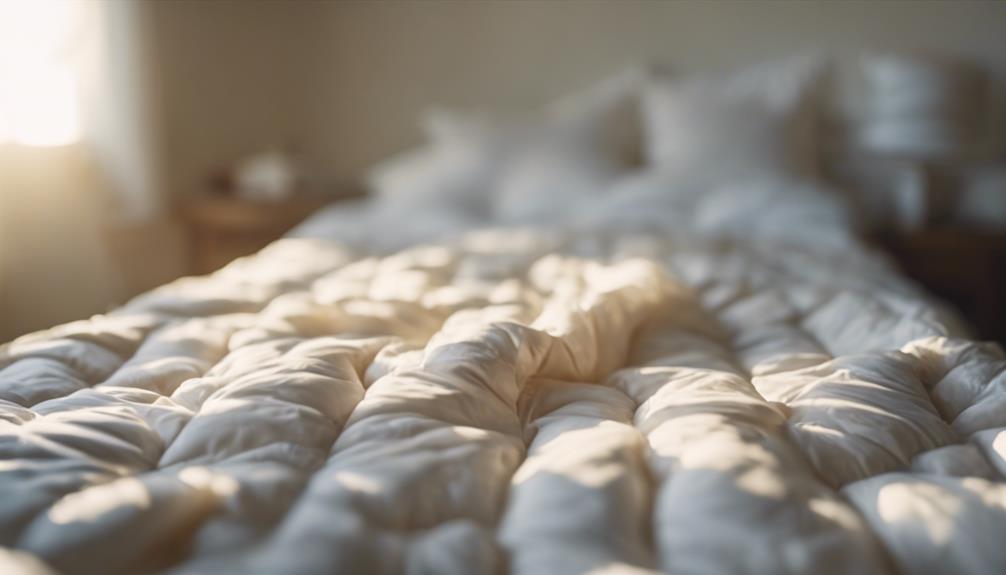
To enhance the fluffiness of a down comforter, one can opt for either the sunlight method or the dryer method with tennis balls. The sunlight method involves hanging the comforter outside for a day to invigorate it and help fluff up the down filling. Exposure to sunlight helps eliminate odors, bacteria, and can improve the loftiness of the comforter. Sunlight is effective for revitalizing comforters and pillows, recommended to leave them outside overnight for best results.
On the other hand, the dryer method with tennis balls includes washing the comforter and drying it with clean tennis balls to prevent clumping and fluff up the comforter. Using tennis balls in the dryer helps maintain the loftiness of the comforter by evenly distributing the down filling during the drying process. Both methods are effective in their ways, with the choice depending on personal preference and convenience.
Impact of Temperature Variations
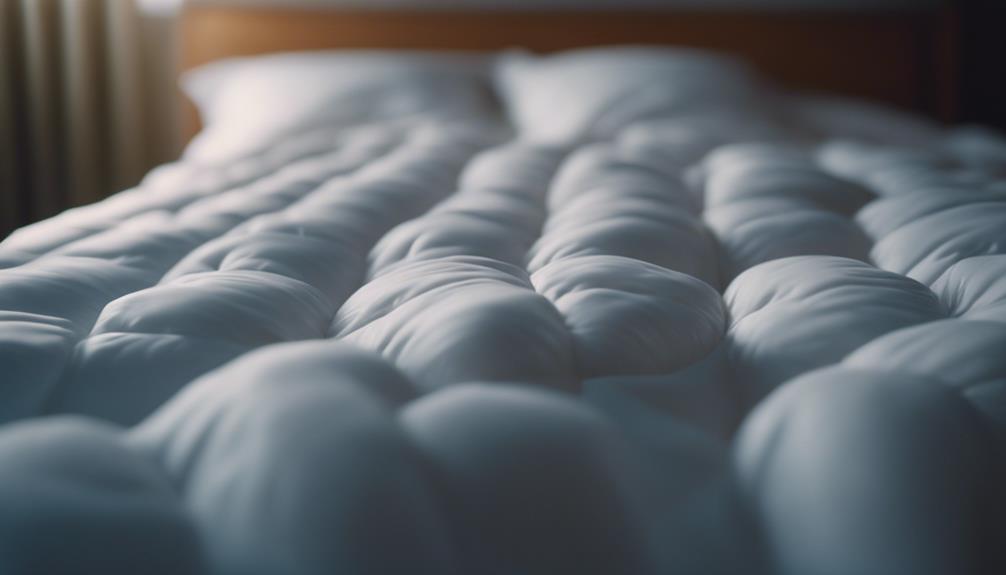
Temperature fluctuations play an essential role in influencing how quickly a down comforter fluffs up. Warmer temperatures can assist the down feathers in expanding and regaining loft more rapidly, expediting the fluffing process. Conversely, colder temperatures may slow down this process, requiring more time for the down comforter to achieve full fluffiness.
Important temperature conditions are vital for enhancing the efficiency of the fluffing up of a down comforter. It's vital to contemplate the ambient temperature in the room where the down comforter is placed to ensure the best results. By selecting a suitable temperature environment, one can positively impact the time it takes for a down comforter to fluff up effectively.
Thus, paying attention to temperature variations is key in facilitating the fluffing process and optimizing the performance of a down comforter.
Understanding Down Filling Behavior

As we explore down filling behavior, it becomes evident that the initial flat appearance of a new down comforter is a common occurrence due to compression during shipping. When a comforter is tightly packed for delivery, the down filling gets squished, reducing its fluffiness.
However, over a few hours on the bed, the down filling will naturally regain its loft and fluffiness as it expands and adjusts to the environment. To expedite this process, daily shaking of the comforter can help redistribute the fill and enhance its loft.
Some new comforters continue to gain loft and fluffiness for up to two weeks after unboxing. If a new down comforter doesn't improve in loftiness over time, it may be a sign to contemplate replacing it to make sure you get the desired level of comfort and warmth.
Understanding how down filling behaves can assist you in maximizing your comforter's fluffiness and longevity.
Patience and Fluffing Expectations

When considering the fluffing process of a down comforter, it's important to manage our expectations.
Understanding the time frame for fluffing, various techniques to enhance loftiness, and the expected results can help us appreciate the progress.
Patience is key as we allow the down comforter to reach its fullest fluffiness potential.
Fluffing Time Frame
Let's discuss the timeframe required for a down comforter to fluff up, emphasizing the need for patience and realistic fluffing expectations. A new down comforter may seem flat initially, but it typically starts regaining its loft after a few hours on the bed. Daily shaking of the comforter can help redistribute the fill and enhance its fluffiness. Some new comforters continue to gain loft for up to two weeks as the down settles and expands. If your comforter doesn't show improved loftiness after this period, it might be time to contemplate a replacement. Proper care, such as shaking and airing out, can maintain and enhance the fluffiness of a down comforter over time.
| Fluffing Time Frame | Expectations |
|---|---|
| Few hours | Initial fluffiness returns |
| Up to two weeks | Continual gain in loft |
| No improvement | Contemplate replacement |
| Proper care | Maintains and enhances fluffiness |
Fluffing Techniques
Exploring effective fluffing techniques for down comforters underscores the importance of patience and managing fluffing expectations.
When using a dryer, it's vital to set it on a low heat setting and add a couple of clean tennis balls to help fluff up the comforter. Remember, the process can take a few cycles to reach the desired level of fluffiness.
Daily shaking and airing out the comforter can also aid in redistributing the down fill and enhancing its loft. It's important to understand that some down comforters may continue to gain loft for up to two weeks as the down settles and fluffs up.
Fluffing Results
As we observe the results of fluffing a down comforter, it becomes evident that patience plays a key role in managing our expectations for achieving peak loftiness. After fluffing, the comforter may still appear flat, but with time and proper care, it will regain its full loft. Regular shaking and airing out the comforter can help maintain its fluffiness. Additionally, using a duvet cover can protect the comforter and assist in preserving its loft over time. For a quick fluff boost, tossing the comforter in the dryer on the air fluff setting can help restore its puffiness. Remember, consistent care and a bit of patience are essential for keeping your down comforter fluffy and cozy.
| Fluffing Results | Tips for Maintaining Fluffiness |
|---|---|
| Initial flatness | Allow time for loft to return |
| Regular shaking | Redistribute fill for loft |
| Air fluff setting | Quick boost for puffiness |
Realistic Fluffing Timeframes

For a new down comforter, it typically takes a few hours on the bed to fluff up and regain its loft. Here are some realistic fluffing timeframes to keep in mind:
- Initial Fluffing: Expect your new down comforter to look flat upon unpacking. Allow it some time on your bed to naturally fluff up and reach its full loftiness potential.
- Daily Shaking: To expedite the fluffing process, shake your comforter daily. This action helps redistribute the down fill evenly, enhancing its loft and overall comfort.
- Continued Fluffing: Some down comforters may continue to gain loft for up to two weeks as the down settles. Be patient and give it time to reach its maximum fluffiness.
- Replacement Consideration: If your new comforter doesn't show significant improvement in loftiness over time, it may be worth considering a replacement. A good down comforter should fluff up and maintain its loft with proper care.
Monitoring Fluffing Progress
When monitoring the fluffing progress of a down comforter, it's important to observe how the fill redistributes over time.
Daily shaking and airing out the comforter can aid in enhancing its loftiness.
Fluffing Timeframes
Monitoring the progress of fluffing a down comforter involves observing how it regains loftiness over time. Here are some key points to keep in mind when monitoring the fluffing timeframes:
- A new down comforter may take a few hours to fully fluff up on the bed.
- Daily shaking and airing out can help the down comforter regain its loftiness.
- Some down comforters continue to gain loft for up to two weeks after unboxing.
- If a new comforter doesn't fluff up within the expected timeframe, contemplate replacing it.
Proper care and maintenance play an important role in expediting the fluffing process of a down comforter.
Fluffing Techniques
To effectively gauge the progress of fluffing a down comforter, a consistent routine of shaking and airing out is essential. Daily shaking helps redistribute the fill inside, enhancing the comforter's loft and fluffiness.
By gently shaking the comforter and allowing it to breathe, you can monitor its progress in regaining its fullness. Remember, some new comforters may continue to gain loft for up to two weeks after unpacking.
If your comforter doesn't regain its fluffiness over time, it might be time to contemplate replacing it. Proper care, including regular shaking and airing out, is key to maintaining and improving the fluffiness of your down comforter.
Frequently Asked Questions
Why Isn't My Down Comforter Fluffy?
If your down comforter isn't fluffy, it may need time to expand after being compressed. Regular shaking and gentle fluffing can help speed up the process. Factors like the down filling type and fabric quality can influence how quickly it fluffs up.
If it stays flat for too long, it might be due to low-quality materials or construction. Give it some time and care, and it should fluff up nicely.
How to Make Your Down Comforter Fluffy Again?
To make your down comforter fluffy again, try daily shaking and airing it out to redistribute the fill and enhance loft. This process can take a few hours to a couple of weeks, depending on the comforter.
If the loft doesn't return, it may be time to replace it. Remember, gentle use, proper washing, and storage are key to maintaining the fluffiness of your down comforter.
Can Down Comforter Go in the Dryer?
Yes, down comforters can go in the dryer on a low heat setting. Using dryer balls helps distribute the down filling evenly. Avoid high heat to prevent damage.
Regularly fluff and dry the comforter to maintain loftiness. Follow the manufacturer's care instructions for safe drying.
It's important to take proper care of your comforter for long-lasting fluffiness.
What to Do When You First Get a Down Comforter?
When you first get a down comforter, it may seem flat initially. To help it fluff up, shake and fluff it daily. This will redistribute the fill and enhance its loftiness.
Some new comforters can take up to two weeks to fully fluff up as the down settles. If your comforter doesn't improve even with care and time, consider replacing it for best comfort and warmth.
– Does the fluffiness of a down comforter affect its safety for toddlers?
When it comes to down comforters for toddlers safety, the level of fluffiness can impact their safety. A down comforter that is too fluffy can potentially pose a suffocation risk for young children. It’s crucial to carefully consider the fluffiness and overall design of the comforter to ensure a safe sleeping environment.
Conclusion
To sum up, the time it takes for a down comforter to fluff up can vary depending on factors like filling type and drying method.
While some may expect instant results, it's important to be patient and understand that fluffing takes time.
By monitoring progress and adjusting methods as needed, you can achieve the desired fluffiness in a realistic timeframe.
Remember, good things come to those who wait and take the time to care for their bedding properly.
Mason – Your Product Expert Mason is your go-to product expert, carefully selecting each item in our collection to ensure it meets your comfort, functionality, and style needs. With his attention to detail and commitment to quality, he ensures that every product we offer enhances your home experience.
Comforter
Is Dry Cleaning a Comforter
Opting for dry cleaning your comforter can enhance its lifespan and appearance, but there's more to discover about this beneficial process.
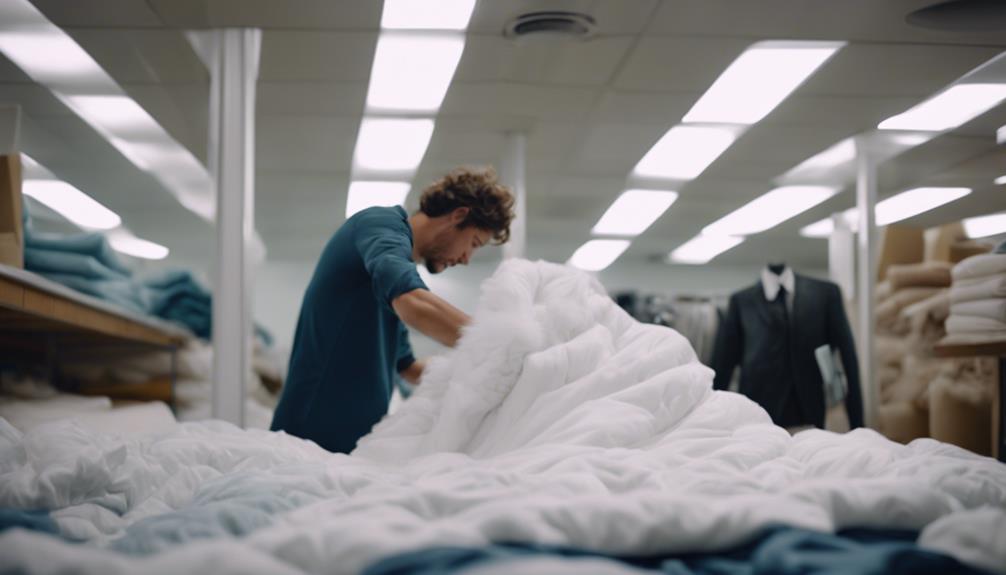
Dry cleaning your comforter is advantageous for delicate fabrics such as silk and wool. This process can effectively eliminate stubborn stains, preserve the quality of the fabric, and prevent shrinkage, ensuring your comforter remains in good condition for a longer period of time. Professional dry cleaning is recommended for intricate designs, heavily soiled comforters, and for maintaining water resistance in wool comforters. It is crucial to follow the care label instructions, especially for delicate fabrics, in order to maintain the quality and appearance of the comforter. Dry cleaning also helps prevent damage that machine washing can cause to delicate fibers. Take these factors into consideration for the best care and longevity of your comforter.
Key Takeaways
- Dry cleaning is suitable for delicate comforter fabrics like silk, wool, and cashmere.
- It effectively removes stubborn stains, preserving fabric quality and color.
- Helps prevent shrinkage and maintains the comforter's original shape and appearance.
- The process involves inspection, specialized cleaning, and drying at specific temperatures.
- Professional dry cleaning extends the comforter's lifespan and ensures thorough cleanliness.
Benefits of Dry Cleaning Comforters

Opting for dry cleaning for your comforter provides a range of benefits that guarantee a thorough and gentle cleaning process. Dry cleaning comforters effectively removes dust mites, skin cells, and oils that accumulate over time, ensuring a deep clean that's hard to achieve with regular machine washing. This process not only cleans the surface but also penetrates deeper layers of the fabric, giving your bedding a fresh and renewed feel.
Moreover, professional dry cleaning prevents lumps and twists in comforters, maintaining their original shape and appearance. By entrusting your comforter to dry cleaning experts, you can rest assured that your bedding will come back looking as good as new. Additionally, dry cleaning preserves the vibrant colors of your comforter and prevents fading, extending its lifespan significantly. It also protects your washing machine from potential damage, as bulky comforters can strain the machine during the washing process. Avoiding machine washing can also prevent shrinkage, ensuring that your comforter fits properly and remains cozy for a long time.
Proper Care for Comforter Fabric
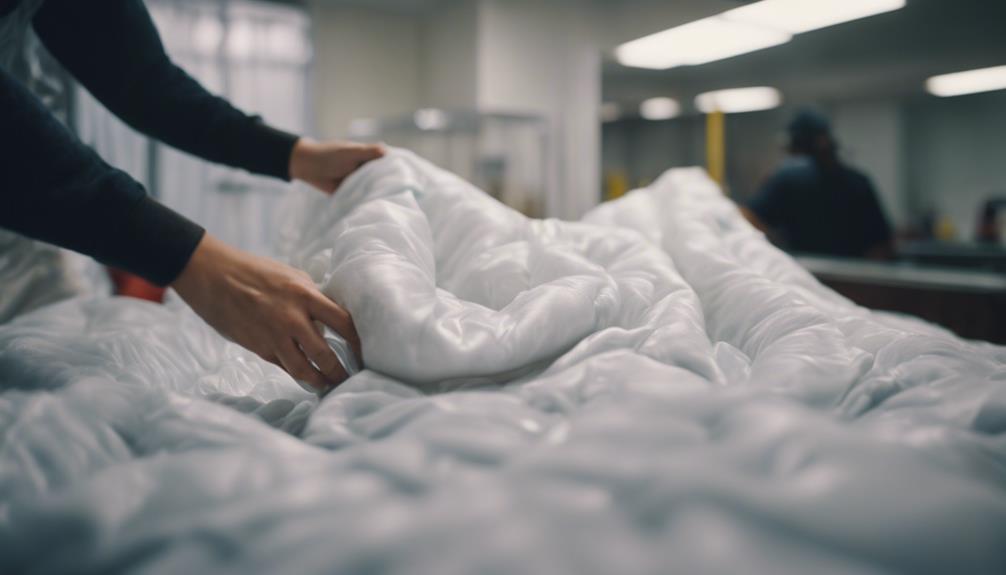
To properly care for comforter fabric, understanding the specific cleaning methods required for different materials is essential. When it comes to maintaining clean bedding, the fabric of the comforter plays a vital role in determining the appropriate care routine.
Wool comforters, for example, are best suited for dry cleaning to preserve their quality and protect the natural fibers from damage that can occur with traditional washing methods. On the other hand, down and synthetic comforters can often be washed, but it's important to have the proper space and equipment to guarantee thorough cleaning.
Utilizing a professional dry cleaning service can help remove dirt and stains effectively while preserving the softness and water resistance of wool comforters, ultimately extending their lifespan.
Dry Cleaning Vs. Machine Washing

When weighing the options between dry cleaning and machine washing a comforter, it's important to evaluate the benefits of each method.
Dry cleaning offers a gentle approach that preserves delicate materials like wool, silk, and cashmere, while machine washing can pose risks by potentially damaging certain fibers.
Understanding the specific care instructions for your comforter, such as recommended cleaning methods, water temperatures, and heat levels, will help you choose the best way to maintain its quality and longevity.
Dry Clean Benefits
Dry cleaning surpasses machine washing by preserving the integrity of bedding materials and safeguarding against potential damage from high temperatures. Professional dry cleaning offers several benefits for comforters and delicate fabrics:
- Shrinkage Prevention: Dry cleaning prevents shrinkage in bedding caused by high temperatures in washers and dryers.
- Thorough Cleaning: Professional dry cleaning guarantees the thorough removal of dirt, dust mites, and skin cells from comforters.
- Appliance Protection: Dry cleaning shields home appliances from potential damage associated with washing heavy and bulky bedding.
Washing Machine Risks
What risks do washing machines pose compared to dry cleaning when cleaning comforters?
Machine washing can damage the delicate fibers of comforters, especially those made of down or wool. The agitation and harsh detergents used in washing machines can strip down comforters of their natural oils and protective layers, leading to reduced softness and durability.
Additionally, house dust mites can survive the washing process in machines, posing a risk to those with allergies. Everyone loses moisture during machine washing, impacting the comforter's ability to retain warmth and fluffiness.
In contrast, dry cleaning offers benefits such as preserving the softness and water resistance of comforters effectively. Considering these factors, it's essential to weigh the risks and benefits when choosing between dry cleaning and machine washing for your comforter.
When to Consider Dry Cleaning

Considering the delicacy of materials like wool, silk, cashmere, or down in your comforter, opting for dry cleaning becomes a prudent choice. Dry cleaning isn't just a luxury but a necessity for certain types of comforters. Here are three key instances when you should consider dry cleaning for your comforter:
- Delicate Materials: If your comforter is crafted from delicate materials such as silk or cashmere, dry cleaning is the safest way to guarantee it remains in pristine condition.
- Intricate Designs: Comforters with intricate designs, embellishments, or special finishes should be dry cleaned to prevent damage during a machine wash cycle.
- Heavily Soiled or Stained: When your comforter is heavily soiled, stained, or has an unpleasant odor, it's a clear sign that it needs professional dry cleaning to restore its freshness and cleanliness.
Dry Cleaning for Delicate Fabrics
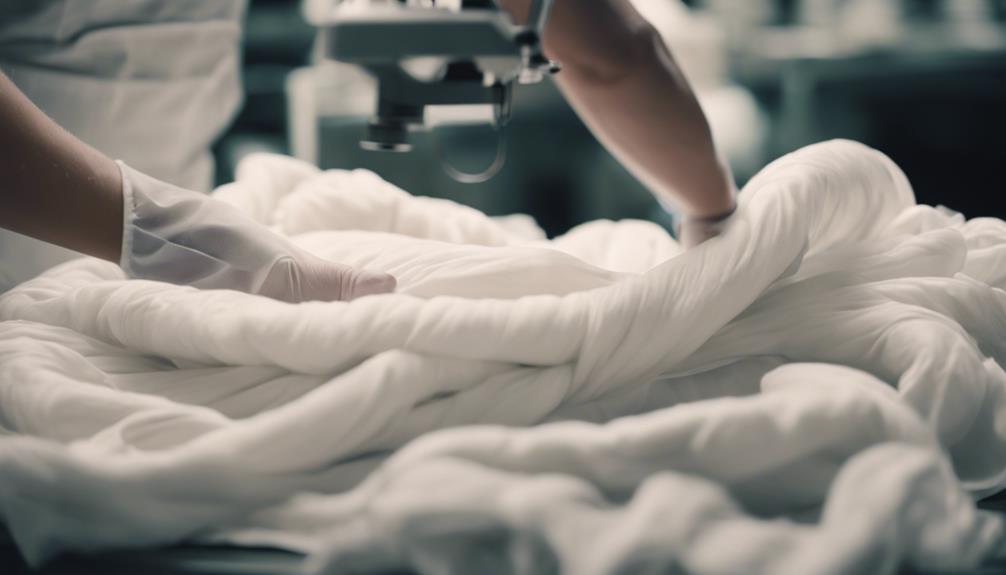
Regularly choosing dry cleaning for delicate fabrics like wool, silk, cashmere, or down is vital to maintain their quality and appearance. Dry cleaning is the preferred method for handling delicate materials due to its gentle nature on fabrics.
When it comes to caring for delicate comforter materials, such as those mentioned, following the care label instructions is essential. These instructions are tailored to guarantee the best cleaning results while preserving the integrity of the fabric.
Dry cleaning for delicate fabrics involves a meticulous process that includes inspection, pretreatment, cleaning in a solvent tank, drying at specific temperatures, and finishing. This method takes approximately 3-4 hours and employs chemical solvents that are specifically formulated to be gentle on delicate fabrics.
Machine washing can potentially damage certain fibers, making dry cleaning the safer choice to maintain the quality and longevity of your delicate comforter materials. Remember, always refer to the care label instructions for proper maintenance and cleaning guidance.
Reasons to Choose Professional Dry Cleaning
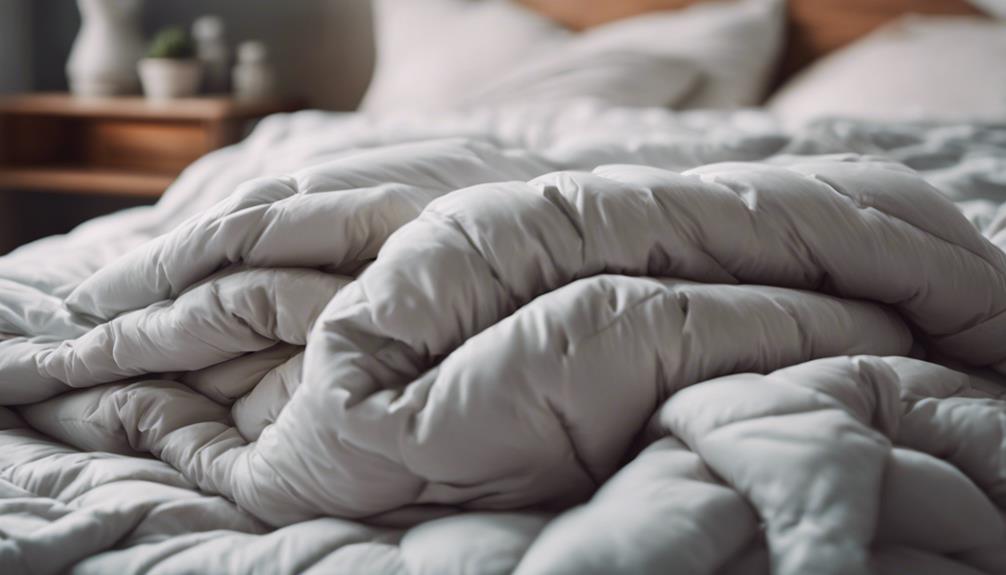
When considering professional dry cleaning for your comforter, there are several key reasons to opt for this service.
Expert handling techniques guarantee proper care for your bedding, preserving its fabric quality over time.
Stubborn stains are effectively removed, leaving your comforter looking fresh and clean after each dry cleaning session.
Expert Handling Techniques
For the best care of your comforter, professional dry cleaning offers expert handling techniques to guarantee thorough cleaning and preservation of its quality. Here are some reasons why professional dry cleaning stands out:
- Specialized Equipment: Professional cleaners use specialized machines and tools designed to handle comforters effectively, ensuring a deep and thorough clean.
- Proper Inspection: Experts carefully inspect comforters for any stains, tears, or specific cleaning requirements before initiating the cleaning process, ensuring individualized care.
- Gentle Treatment: Professional cleaners understand the delicate nature of comforters and use gentle cleaning agents and techniques to prevent damage while effectively removing dirt and allergens.
Choosing professional dry cleaning guarantees your comforter receives the best care possible, maintaining its cleanliness and quality for a longer period.
Preserve Fabric Quality
To maintain the fabric quality of your comforter, opting for professional dry cleaning guarantees gentle care and effective removal of dirt and stains while preserving the original softness and appearance of delicate materials.
Professional dry cleaning is specifically designed to handle delicate fabrics like silk, wool, and cashmere with the utmost care. The chemical solvents used in the dry cleaning process are gentle on these materials, ensuring they maintain their softness and appearance over time.
Remove Stubborn Stains
Choosing professional dry cleaning guarantees the effective removal of stubborn stains like blood, grease, and oil from comforters while preserving their fabric quality. When opting for professional dry cleaning, you benefit from:
- Effective Stain Removal: Professional dry cleaning techniques target tough stains, ensuring your comforter looks fresh and clean.
- Prevention of Shrinkage: By trusting your comforter to professionals, you avoid the risk of shrinkage that can occur with improper cleaning methods.
- Color Preservation: The colors of your comforter are safeguarded through professional dry cleaning, reducing the chances of fading even after multiple washes.
These benefits not only keep your comforter looking its best but also extend its lifespan for long-lasting enjoyment.
Steps for Dry Cleaning a Comforter

When dry cleaning a comforter, the process involves thorough inspection, pretreatment, cleaning in a solvent tank, drying at specific temperatures, and finishing. To give you a clearer picture, here is a breakdown of the steps involved in dry cleaning a comforter:
| Dry Cleaning Steps | Description | Time Taken |
|---|---|---|
| Inspection | Check for stains, tears, or damage. | 15 minutes |
| Pretreatment | Apply specialized stain removers. | 10 minutes |
| Cleaning | Place in a solvent tank for deep cleaning. | 1-2 hours |
| Drying | Dry at specific temperatures to avoid damage. | 30 minutes |
| Finishing | Pressing, folding, and packaging. | 15 minutes |
The use of chemical solvents in the cleaning process guarantees that delicate materials like wool, silk, cashmere, or down are treated gently and effectively. This method not only helps maintain the cleanliness of your comforter but also preserves its quality, especially for sensitive fabrics.
Maintaining Comforter Longevity

To maintain comforter longevity, it's essential to adhere to a regular cleaning schedule and adopt proper storage techniques. Cleaning frequency, such as dry cleaning every three months, helps keep the comforter fresh and extends its lifespan.
Additionally, storing the comforter in a breathable bag or container when not in use can prevent dust accumulation and preserve its quality over time.
Cleaning Frequency
Using a duvet cover can greatly impact the longevity of your comforter by maintaining cleanliness and freshness throughout the year. When considering the cleaning frequency for your comforter, it's crucial to assess your specific needs to guarantee a comfortable and hygienic sleep environment.
Here are some guidelines to help you determine how often your comforter needs cleaning:
- Wash the comforter several times per year with a duvet cover to keep it fresh.
- If using a top sheet, consider washing the comforter every 2-4 weeks to prevent dirt and odor buildup.
- Without a duvet cover or top sheet, weekly washing may be necessary, especially if factors like sweating, stains, spills, or pets are present.
Adjust your cleaning routine based on personal circumstances to maintain an ideal level of comfort and cleanliness.
Proper Storage Techniques
Considering the importance of maintaining the longevity of your comforter, proper storage techniques play a vital role in preserving its quality and freshness over time. To guarantee your comforter stays clean and fresh, follow these storage guidelines:
| Storage Tip | Description |
|---|---|
| Store in a breathable cotton bag | Prevents musty odors and mold growth. |
| Avoid plastic bags or containers | Prevents moisture buildup and mildew. |
| Keep in a cool, dry place away from direct sunlight | Maintains fabric integrity. |
| Regularly air out in a well-ventilated area | Prevents trapped odors and maintains freshness. |
| Store flat or loosely folded to maintain fluffiness | Prevents creases and maintains the fluffiness of the filling. |
Dry Cleaning Cost Analysis

Dry cleaning a comforter typically incurs a cost ranging from $20 to $50, influenced by factors such as location, material, and size. When considering the cost analysis of dry cleaning, it's essential to keep in mind the following:
- Material and Size: The type of material your comforter is made from will impact the overall cost of dry cleaning. Additionally, the size of the comforter plays a significant role in determining the final price you'll pay for the service.
- Duvet Covers: Duvet covers are usually not included in the standard dry cleaning cost for comforters. These covers are designed to protect the comforter itself, reducing the need for frequent dry cleaning.
- Machine Washed Concerns: While machine washing may seem like a cost-effective alternative, it can potentially harm the delicate natural coating of feathers in down comforters, affecting their softness and fluffiness over time.
Dry Cleaning for Specialized Fabrics
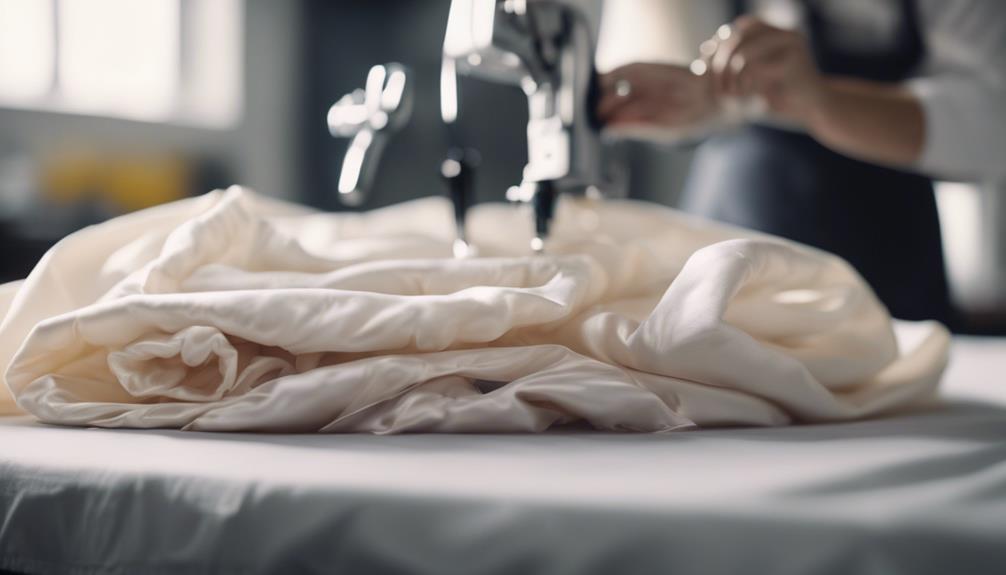
Preserving the quality and longevity of specialized fabrics like wool comforters often necessitates professional dry cleaning services. Wool comforters, in particular, benefit from dry cleaning to maintain their protective coating and water resistance. Washing a wool comforter at home can strip it of these essential properties, potentially leading to damage over time. On the other hand, down comforters can usually be washed, but it's important to have the proper space and equipment for cleaning to safeguard their longevity.
To highlight the importance of proper drying techniques after dry cleaning these specialized fabrics, consider the following table:
| Fabric Type | Cleaning Method | Drying Technique |
|---|---|---|
| Wool Comforters | Dry Cleaning | Gentle Air Fluff or Air Dry |
| Down Comforters | Washable | Low Heat Tumble Dry or Line Dry |
Implementing the correct drying method is essential to prevent odors and maintain the fluffiness of both wool and down comforters after dry cleaning.
Frequently Asked Questions
Is It Okay to Dry Clean a Comforter?
It's completely okay to dry clean a comforter if you want to maintain its quality and cleanliness.
Dry cleaning is a recommended method for delicate materials like wool, silk, cashmere, or down. The process involves inspection, pretreatment, cleaning in a solvent tank, drying at specific temperatures, and finishing touches for a thorough clean.
It's gentle on fabrics and effectively removes dirt, dust, and stains.
Is Dry Cleaning a Comforter Expensive?
Dry cleaning a comforter can vary in cost, typically ranging from $20 to $50. Factors like location, material, and size influence the price. Additional fees may apply for repairs during the cleaning process.
While the initial expense might seem high, proper care extends the comforter's lifespan, potentially saving on replacement costs. Adhering to care label instructions can help maintain quality.
Duvet covers, unlike comforters, usually don't need dry cleaning and can be washed at home.
How Much Does It Cost to Wash a Comforter?
Washing a comforter can cost between $20 and $50, depending on factors like location, size, and material. Additional charges might apply for repairs or stubborn stains. Following care label instructions is crucial to maintain your comforter's quality.
Duvet covers, which protect comforters, typically don't need dry cleaning and can be washed separately. Machine washing down comforters may damage the feathers' natural coating, affecting softness and fluffiness over time.
Are Down Comforters Really Dry Clean Only?
Down comforters are marked 'dry clean only' to protect their delicate feathers. The natural oils in down can be damaged by water, affecting their softness and fluffiness if machine washed. Dry cleaning helps maintain their loftiness and insulating properties. Following care label instructions is crucial to guarantee longevity and comfort.
Dry cleaning preserves the luxurious feel of down comforters, making it a recommended method for their care.
Can I Avoid Dry Cleaning My Comforter and Still Keep It Clean?
Yes, you can avoid dry cleaning comforters and still keep them clean. Regularly airing out your comforter, spot cleaning as needed, and using a duvet cover can help prevent the need for dry cleaning. Additionally, some comforters are machine washable, which can also eliminate the need for dry cleaning.
Conclusion
To summarize, dry cleaning a comforter can symbolize the care and attention we give to our personal space and well-being. By properly maintaining and cleaning our comforters, we not only prolong their lifespan but also guarantee a clean and cozy environment for rest and relaxation.
Consider the benefits of dry cleaning for delicate fabrics or when machine washing may not suffice. With proper care and maintenance, your comforter can continue to provide comfort and warmth for years to come.
-
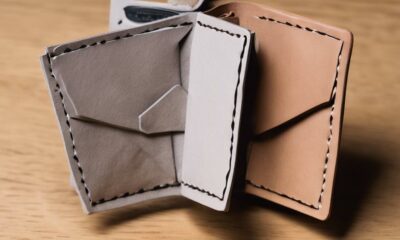
 Vetted6 months ago
Vetted6 months ago14 Best Personalized Father's Day Gifts for Your Husband – Show Him You Care
-

 Alfresco6 months ago
Alfresco6 months agoAlfresco Stacker Doors: Seamless Indoor-Outdoor Living!
-

 Vetted7 months ago
Vetted7 months ago15 Best EMS Foot Massagers for Neuropathy to Soothe Your Feet
-

 Craft and Textiles7 months ago
Craft and Textiles7 months ago15 Best Places to Buy Appliances for Your Home – Top Retailers Reviewed
-

 Tableware and Dining Accessories7 months ago
Tableware and Dining Accessories7 months agoWhat Is the Meaning of the Word Tableware
-
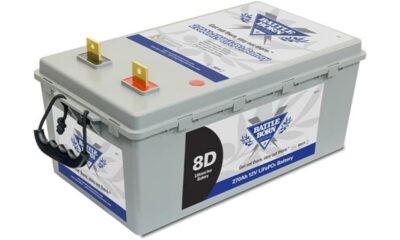
 Vetted5 months ago
Vetted5 months agoBattle Born Batteries Review: Reliable Power Solution
-

 Vetted5 months ago
Vetted5 months agoD-Link Switch Review: Lite Layer 3 Managed Networking
-

 Tableware and Dining Accessories7 months ago
Tableware and Dining Accessories7 months agoWhen Is Tableware on Sale at Hobby Lobby





























